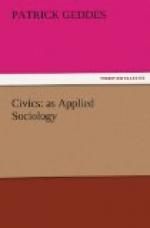[9] Tarde, “L’imitation Sociale,” and other works.
Once more, then, and in the fullest sense, every folk has its own tradition, every town its school.
We need not here discriminate these unique and characteristic elements to which the art-historians—say of Venice and of Florence, of Barbizon or Glasgow—specially attend from those most widely distributed ones, in which the traditions and schools of all towns within the same civilisation broadly agree. Indeed, even the most widely distributed of these—say from Roman law to modern antiseptic surgery—arose as local schools before they became general ones.
Similarly for the general social tradition. The fundamental occupations and their division of labour, their differentiation in detail and their various interactions up to our own day, at first separately considered, are now seen to be closely correlated with the status of woman; while all these factors determine not only the mode of union of the parents, but their relation to the children, the constitution of the family, with which the mode of transmission of property is again thoroughly interwoven.
H—TOWN AND SCHOOL COMPARED
“TOWN” FOLK
WORK
PLACE
SURVEY
CRAFT-KNOWLEDGE
“SCHOOL” CUSTOM
We may now summarise and tabulate our comparison of Town and School,[10] and on the schema (p.75) it will be seen [Page: 76] that each element of the second is printed in the position of a mirror-reflection of the first. This gives but the merest outline, which is ready, however, to be applied in various ways and filled up accordingly. A step towards this is made in the next and fuller version of the scheme (p. 77). It will be noted in this that the lower portion of the diagram, that of School, is more fully filled up than is the upper. This is partly for clearness, but partly also to suggest that main elements in the origins of natural sciences and geography, of economics and social science, are not always so clearly realised as they might be. The preceding diagram, elaborating that of Place, Work, Folk (p. 75), however, at once suggests these. Other features of the scheme will appear on inspection; and the reader will find it of interest and suggestiveness to prepare a blank schedule and fill it up for himself.
[10] For the sake of brevity, an entire chapter has been omitted, discussing the manifold origins of distinct governing classes, whether arising from the Folk, or superimposed upon them from without, in short, of the contrast of what we may broadly call patricians and plebeians, which so constantly appears through history, and in the present also. These modes of origin are all in association respectively with Place, Work, and Family, or some of the various interactions




